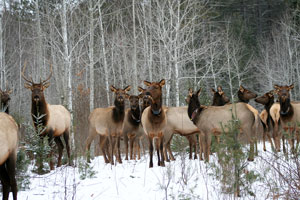Wisconsin Elk Reintroduction Wraps Up

In a quarantine pen in Wisconsin, 48 elk multiplied into more than 60 animals as pregnant cows gave birth to new arrivals. In March 2019, the Wisconsin Department of Natural Resources (DNR) translocated the elk from Kentucky to the northern Wisconsin quarantine pen in the final stage of the state’s elk reintroduction efforts.
Once widespread, elk populations disappeared from Wisconsin in the 1880s, buckling under the weight of unregulated hunting and habitat loss. Over 130 years later, bugles ring out again in the central and northern forest regions. Today, the state’s total elk population is approaching 400 animals. RMEF funds and volunteers have been part of every stage of the reintroduction effort.
In 1989, the DNR was directed by the state legislature to test the feasibility of reintroducing elk, moose and caribou to the state. Researchers determined that only an elk reintroduction could succeed. In 1993, the Wisconsin state legislature authorized the University of Wisconsin-Stevens Point (UW-SP) to evaluate reintroducing elk to the Chequamegon-Nicolet National Forest near Clam Lake.
In February 1995, Wisconsin’s first 25 wild elk in 130 years stepped out of the pen on May 17 with RMEF volunteers and board members standing by.
Management responsibility of the herd fell to the DNR in May 1999, after the success of the initial UW-SP reintroduction study. At that time, the herd numbered about 40 elk.
In 2014, the DNR entered into an agreement with the state of Kentucky to import, quarantine and release as many as 150 wild elk over a period of five years. The overall plan involved releasing up to 75 elk to establish a new herd in the Black River State Forest with a long-term population goal of 390 elk. In 2015 and 2016, the DNR released 73 elk.
The plan also called for adding up to 75 elk to the existing Clam Lake herd with a long-term population goal of 1,400 elk. In 2017, the DNR released 31 Kentucky elk into the Flambeau River State Forest near the town of Winter.
The 2019 translocation marked the final year of the project and was also the most efficient and successful translocation to date. In the past, Kentucky elk were trapped in corral traps, but this year, the elk were netted from helicopters. Once the helicopter landed, two people hogtied and blindfolded the netted animal. The elk were wrapped in a sleeve-like blanket, hoisted into the air and taken to a truck Wisconsin-bound. RMEF paid the costs for the helicopter trapping.
Each animal, including the newborn calves, were fitted with tracking collars to provide useful movement, habitat use and survival data.
Hunters are reaping the benefits of all the labor. The DNR held its first managed elk hunt in Wisconsin history with the Clam Lake herd last fall. Hunters killed nine bulls out of a 10-bull quota. This fall, came another new success, as Lydia Pernsteiner became the first woman ever to harvest a Wisconsin elk in a regulated hunt.